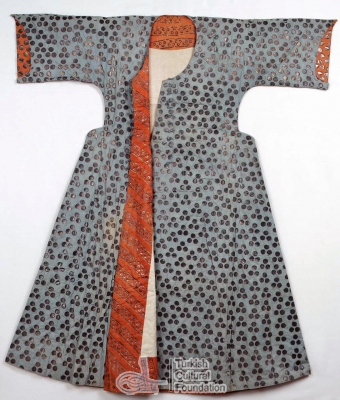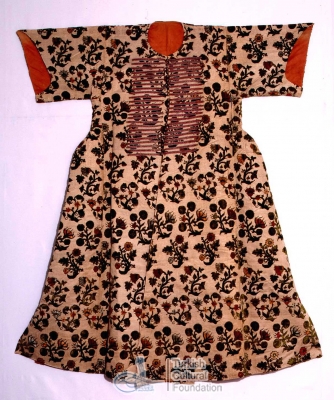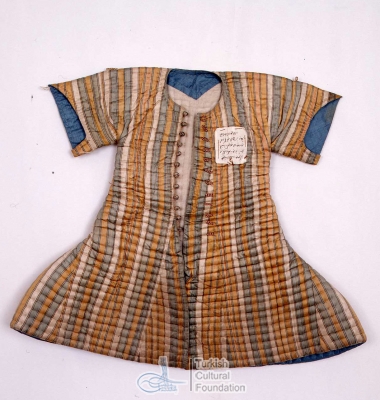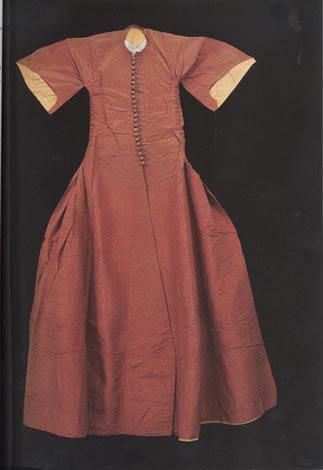Everybody knows there are no pink or orange 16th-century garments in the Topkapi Palace collections. Right? I certainly thought so, and I’ve spent a couple years on this. Some friends set me right.
A note: Photos of the Topkapi collection range from the pornographically detailed to the godawful. A few dozen pieces, the most beautiful brocades with the most enthralling details, have been photographed from all angles, in all lights, so beautifully that you can see individual threads. The other several hundred pieces were photographed in the dark. From another room. With a broken Polaroid.
Under these conditions, it can be hard to tell, say, hot pink from red. I include the source of all the photos I used to decide what color a given garment is. If you have an alternate source, especially a photograph you shot yourself under good light, I would love to see it.
13/199: Velvet kaftan of “faded red silk”
This long-sleeved kaftan is associated with Murad III, and was worn before his accession in 1574. (The source for the dating, Topkapi Textiles, is dubious.) It appears to be a medium reddish orange. Topkapi Textiles calls the color “faded red,” but doesn’t specify whether the dye was originally red and faded, or whether “faded red” is just a description of the color. The color appears to be even throughout (and fading is rarely a problem in the Topkapi collection), so I believe the kaftan was deliberately dyed an off shade.
- Topkapi Textiles, plate 24, description p. 153.
13/221: Hil’at with “cinnamon” details and lining
The white silk ground of this ceremonial outer robe, or hil’at is patterned with gold(?) designs and medium brownish-orange crescents that Topkapi Textiles describes as “cinnamon.” The lining is the same color.
The robe is associated with Murad III (ruled 1574-1595). The source for the dating, Topkapi Textiles, is dubious.
- Topkapi Textiles, plate 25, description p. 153.
13/198, 13/: Ayşe Sultan’s blue kaftan and salmon pink zibin stamped with silver cintamani

This set of matching kaftan and hirka is made of medium blue and salmon pink silk. It was made for Ayşe Sultan (1570-1605), daughter of Murad III.
- Topkapi Textiles, plate 26, description p. 153.
- Tezcan, Hu:lya. “Sixteenth and Seventeenth-Century Women’s Fashion at the Ottoman Palace,” P, Issue 3, Spring/Summer 2000. Pp. 4-17.
13/835: Italian velvet kaftan with orange lining

This fussily patterned kaftan has an unmistakably orange lining, more saturated than 13/221 but of a similar hue. The kaftan is associated with Mehmed III (ruled 1595-1603), although the source for the dating, Topkapi Textiles, is dubious.
- Topkapi Textiles, plate 28, description p. 153.
13/275: Badly made girl’s quilted zibin of striped satin

The irregular stripes of this lumpy zibin include medium pink and orange.
The zibin is attributed to Hanzade Sultan, daughter of Ahmed I, and dates to the early 17th century.
- Topkapi Textiles, plate 36, description p. 154.
Hanzade Sultan’s Rose-Pink Kaftan

This rose-pink/dusty rose moire silk kaftan was taken in at the sides, probably to fit the 13-year-old Hanzade Sultan at the time of her marriage.
13/263: Sehzade Kasim’s striped pink jacket
This short quilted jacket or zibin is decorated with wide candy-pink stripes and matching pink buttons. It’s attributed to Sehzade Kasim (1614-1638). Because it’s adult-sized, it probably dates to the 1630’s.
- Topkapi Textiles, plate 37, description p. 154.
13/357: Raw silk hil’at with a band of orange patterning and orange lining
This hil’at is associated with Osman II (ruled 1618-1622).
- Topkapi Textiles, plate 40, description p. 154.
Sources
P, Issue 3, Spring/Summer 2000.
Topkapi Textiles: Tezcan, Hulya and Delibas, Selma. The Topkapi Saray Museum: Costumes, Embroideries and Other Textiles. Trans. J.M. Rogers. Boston: Little, Brown and Company, 1986.
The dating in this book is dubious.



